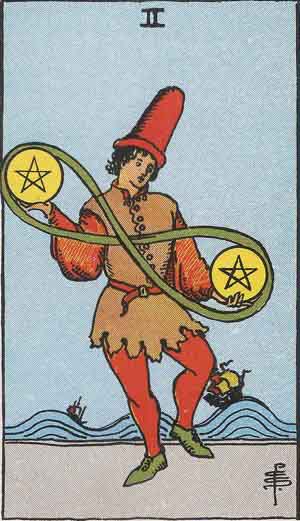 Picture a street performer juggling two plates; one plate goes up, the other down. Something about the juggler’s ability to keep them in the air, to defy the boundaries of gravity and human movement, has fascinated people since ancient times. Maybe the mystery of juggling reminds us of the mystery of the movement from day to night or the changing of the seasons. Whatever it is, this juggling of opposites pervades our religions, our philosophies, and our sciences. Heaven and earth, good and evil, mind and body–we divide everything into two, and we spend much of our lives learning how to balance these opposites. Even as babies, we must learn that the outside world is not the same as our bodies.
Picture a street performer juggling two plates; one plate goes up, the other down. Something about the juggler’s ability to keep them in the air, to defy the boundaries of gravity and human movement, has fascinated people since ancient times. Maybe the mystery of juggling reminds us of the mystery of the movement from day to night or the changing of the seasons. Whatever it is, this juggling of opposites pervades our religions, our philosophies, and our sciences. Heaven and earth, good and evil, mind and body–we divide everything into two, and we spend much of our lives learning how to balance these opposites. Even as babies, we must learn that the outside world is not the same as our bodies.
 Achieving this balance is a lifelong journey, and the Tarot offers a guide for that journey. The twos of the Major Arcana give us the direction; the twos of the Minor Arcana give us the vehicle. The High Priestess, the second card of the Major Arcana, shows dualistic thought emerging from its source in the unconscious. She shows us the inner source of all our desires, a glimpse beyond dualism to the unity of mind in the water behind her veil. Yet even to grasp the undivided life of the unconscious, we must begin to divide: the veil divides the High Priestess from the water behind her; foreground is divided from background. She shows the path to oneness, but the path itself can only be expressed by a division.
Achieving this balance is a lifelong journey, and the Tarot offers a guide for that journey. The twos of the Major Arcana give us the direction; the twos of the Minor Arcana give us the vehicle. The High Priestess, the second card of the Major Arcana, shows dualistic thought emerging from its source in the unconscious. She shows us the inner source of all our desires, a glimpse beyond dualism to the unity of mind in the water behind her veil. Yet even to grasp the undivided life of the unconscious, we must begin to divide: the veil divides the High Priestess from the water behind her; foreground is divided from background. She shows the path to oneness, but the path itself can only be expressed by a division.
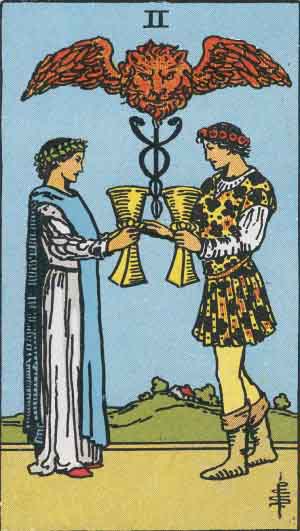 The suit cards deal with this division. The Two of Cups gives us the union of male and female. The man, embodying the active principle of life, steps forward and reaches out to the woman, who embodies the passive principle. This stepping forward is the attempt to overcome through love the separateness that characterizes all human life–the attempt to know that we are not alone in the world, that there is another heart out there that understands us completely.
The suit cards deal with this division. The Two of Cups gives us the union of male and female. The man, embodying the active principle of life, steps forward and reaches out to the woman, who embodies the passive principle. This stepping forward is the attempt to overcome through love the separateness that characterizes all human life–the attempt to know that we are not alone in the world, that there is another heart out there that understands us completely.
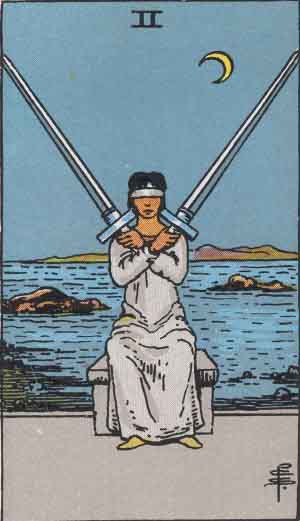 The Two of Swords shows a much different attitude. On a gray stone bench, similar to the High Priestess’ own, sits another woman who is not as calm. Like the High Priestess, this woman has water behind her, but threatening rocks break the surface. She is blind to the water, blindfolded to all around her; she holds two swords crossed over her chest, and her arms must be growing weary. For this woman, the water of the unconscious is troubled, and no veil softens its storms. Sometimes, the unconscious is too close to the surface, and this woman’s defensiveness can seem like the only solution. But she does not look comfortable, and her arms will not hold out forever.
The Two of Swords shows a much different attitude. On a gray stone bench, similar to the High Priestess’ own, sits another woman who is not as calm. Like the High Priestess, this woman has water behind her, but threatening rocks break the surface. She is blind to the water, blindfolded to all around her; she holds two swords crossed over her chest, and her arms must be growing weary. For this woman, the water of the unconscious is troubled, and no veil softens its storms. Sometimes, the unconscious is too close to the surface, and this woman’s defensiveness can seem like the only solution. But she does not look comfortable, and her arms will not hold out forever.
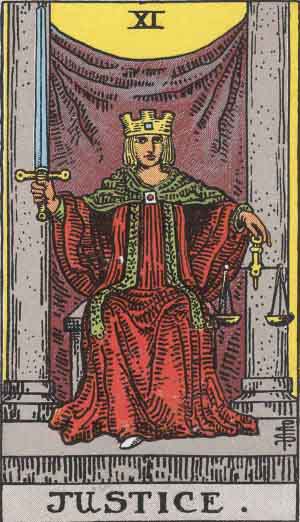 From the seated figure of the Two of Swords, we move to the seated figure of Justice. Justice is card 11 of the Major Arcana, and the two ones of 11 add up to two. Unlike the woman in the Two of Swords, she has no blindfold and she sees the truth clearly. Her sword is drawn, but so are her scales, and with these she regains the balance that seemed so precarious in the Two of Swords. With Justice as with the High Priestess, the veil is drawn between two columns, but with Justice no water lies behind the veil. This card brings us from the pure unconscious energy of the High Priestess, through the attempt to merge conscious and unconscious in the Two of Cups, through the near breakdown of consciousness in the Two of Swords, to the full power of the conscious mind. Justice is virtue pursued with reason, and this power of understanding and accepting the moral consequences of our actions is what makes us fully human.
From the seated figure of the Two of Swords, we move to the seated figure of Justice. Justice is card 11 of the Major Arcana, and the two ones of 11 add up to two. Unlike the woman in the Two of Swords, she has no blindfold and she sees the truth clearly. Her sword is drawn, but so are her scales, and with these she regains the balance that seemed so precarious in the Two of Swords. With Justice as with the High Priestess, the veil is drawn between two columns, but with Justice no water lies behind the veil. This card brings us from the pure unconscious energy of the High Priestess, through the attempt to merge conscious and unconscious in the Two of Cups, through the near breakdown of consciousness in the Two of Swords, to the full power of the conscious mind. Justice is virtue pursued with reason, and this power of understanding and accepting the moral consequences of our actions is what makes us fully human.
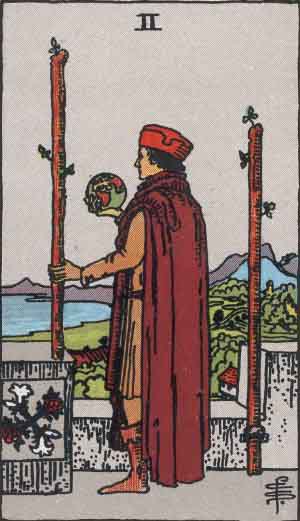 From Justice we return to the Minor Arcana. The Two of Wands has achieved the humanity signaled by Justice. A man in maturity stands atop a castle, overlooking a village and the sea. He hold a small world in his hands. He has channeled and contained the creativity of the wands and the power of water, and he has much to show for it. He has balanced the opposing forces in his life; his world has harmony between land and sea, society and nature.
From Justice we return to the Minor Arcana. The Two of Wands has achieved the humanity signaled by Justice. A man in maturity stands atop a castle, overlooking a village and the sea. He hold a small world in his hands. He has channeled and contained the creativity of the wands and the power of water, and he has much to show for it. He has balanced the opposing forces in his life; his world has harmony between land and sea, society and nature.
Rachel Pollack has suggested that this man in the castle may be too accomplished1; with such perfect balance, what is there left to do? Here we return to our juggler, the man of the Two of Pentacles. For no matter how high we rise in the world, we should never lose our sense of fun; also, we can never forget that the street performer juggling for coins is as human and needed as the leader in his castle. The juggler gives back some of the conscious control of the Two of Wands; in return he receives the beauty of dance and play, because true harmony needs an element of chaos to balance control. The rolling waves behind him, their unconscious power, remind us that the world, though so small in the hands of the man in the castle, is bigger than us all.
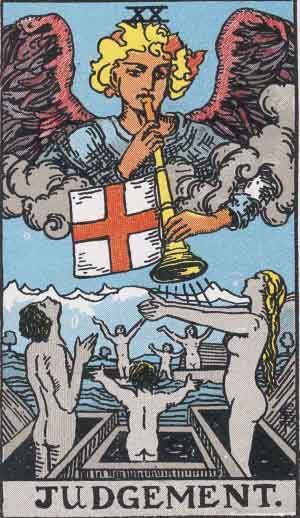 The final call of the twos of the Tarot comes in the Judgement card, number 20, two multiplied by ten; this is the call from our original home to regain that oneness we left behind the veil of the High Priestess, the call to rise up and rejoin each other in a realm outside time. We cannot wait for this Judgement to come, however, because it is already here; that possibility to overcome suffering and discover joy exists in every second if we are aware of it. It is the reason the juggler never drops his plates, the day never loses its night, and the kitten never loses her purr. That home is always with us; we have only to listen to its call.
The final call of the twos of the Tarot comes in the Judgement card, number 20, two multiplied by ten; this is the call from our original home to regain that oneness we left behind the veil of the High Priestess, the call to rise up and rejoin each other in a realm outside time. We cannot wait for this Judgement to come, however, because it is already here; that possibility to overcome suffering and discover joy exists in every second if we are aware of it. It is the reason the juggler never drops his plates, the day never loses its night, and the kitten never loses her purr. That home is always with us; we have only to listen to its call.
1. Pollack, Rachel. Seventy-Eight Degrees of Wisdom. San Francisco: Red Wheel/Weiser, LLC, 2007, p. 181.
2008-01-17